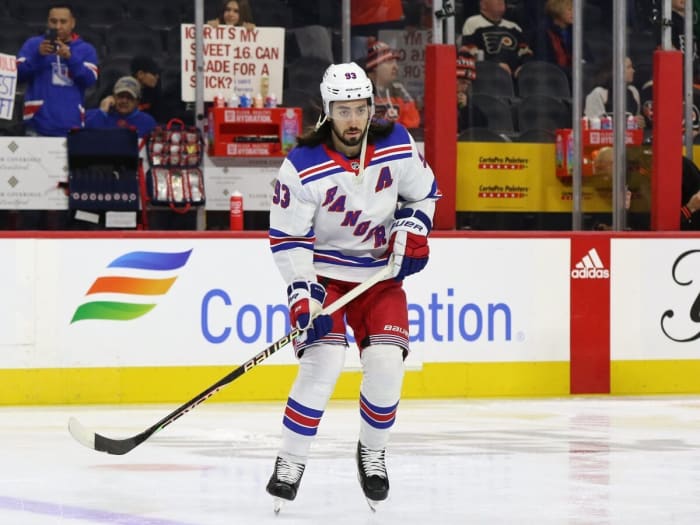
Last season was a disaster for the New York Rangers. They missed the playoffs, despite high expectations heading into the campaign. What’s worse is that over 68% of their cap space is locked into seven players, several of whom are signed into their late 30s. Mika Zibanejad’s contract expires in 2030, his age 36 season; J.T. Miller’s also expires then, his age 36 season. Vladislav Gavrikov’s contract runs through 2031, when he will be 35.
The Rangers’ only hope for flexibility, between the contracts and the no-movement and no-trade clauses, will come from the cap going up. Even then, the team signed Juuso Pärssinen to a contract with a $1.25 million AAV, as a depth piece, and they traded for Carson Soucy’s $3.25 million AAV deal, although he’s a shell of what he once was. With the cap increasing, some of these deals will look better. But even the team’s three best deals have their problems – the Rangers don’t have a single contract without at least one big issue. Here’s a look at the Rangers’ three best and three worst contracts heading into 2025–26.
The Three Best Contracts
Let’s be clear. “Best” is a relative term. None of New York’s contracts are perfect, and all three of these deals have at least one red flag, whether it’s age, term, or risk of decline. But in terms of production vs. cap hit, these are the deals (in no particular order) that offer the Rangers the most value heading into 2025–26.
J.T. Miller — $8 million with 5 years left
J.T. Miller’s deal isn’t a bargain, but he’s probably the closest thing the Rangers have to one. He’s their first-line center, produces at a point-per-game pace, had 103 points two seasons ago, plays heavy minutes, and plays with an edge. The $8 million cap hit is already good value, and it’s going to look even better as the salary cap continues to rise.
The concern is the term. He’s signed until he’s 36, and while the decline hasn’t started yet, you don’t have to squint too hard to see how this might look two or three years from now. But in the present, he’s worth every dollar.
Adam Fox — $9.5 million with 4 years left
Fox had a down year. There’s no sugarcoating it. He wasn’t bad, but he wasn’t at the level we’ve come to expect from him, especially defensively. Even so, he’s still a top-pairing, right-shot blueliner who quarterbacks the top power play, and still plays heavy minutes against top competition.
At $9.5 million, he isn’t cheap, but his contract is aging well. If he bounces back this season, this could still be one of the more team-friendly deals on the roster. If he doesn’t, it becomes more complicated, but right now, the bet still makes sense.
Vincent Trocheck — $5.625 million with 4 years left
Vincent Trocheck is mentioned a lot, and for good reason. He’s been one of the Rangers’ most consistent and impactful players over the last three seasons. He has had 64, 77, and 59 points, plays in all situations, takes tough matchups, and brings an edge that fits exactly what this team needs down the middle.
His contract looked like a risk when it was signed, mostly because of the term. That concern hasn’t gone away. He’s signed through his age-35 season, and at some point, he will likely decline, but with the cap rising, this deal will always be movable or easy to carry. For now, at $5.625 million, he’s giving the Rangers real value, and this deal isn’t one of the problems.
There’s a pattern here. All three players had down years in 2024-25, which hopefully can be chalked up to the team’s overall dysfunctional season. But the concern about term continues into the next list, which points to a deeper issue with how the Rangers manage their cap.
The Three Worst Contracts
Like the “best” list, everything here is relative. None of these deals is franchise-crippling on its own, but each one raises real questions about how the team is managing its window, its aging curve, and its ability to build around a locked-in core.
Mika Zibanejad — $8.5 million with 5 years left
This is one of the worst, if not the worst, contracts in the NHL right now. Zibanejad is still a capable player, but he’s no longer a first-line center or winger. His five-on-five production has fallen off. He’s not driving play. He’s not defending at a high level. Yet, he’s signed until 2030 with an air-tight no-movement clause until his deal expires.

The Rangers are likely to shift him to the first-line right-wing spot to try to get him going again, which will probably come at the expense of a younger player. That’s the ripple effect of a bad contract – it forces teams to make bad decisions to justify the deal.
If there’s such a thing as a franchise-ruining contract, this might be it. It’s expensive, it’s long, there’s no flexibility, and it’s tied to a player whose best years are already behind him. The Rangers are stuck with it, and the league knows it.
Carson Soucy — $3.25 million with 1 year left
Soucy’s deal has only one year left, but it’s on this list because trading for him made no sense. His play last season was a clear step down. He looked slow, uncomfortable, and not like a player worth $3.25 million.
The Rangers took a gamble by acquiring Soucy at the trade deadline in March, and it didn’t pay off. Adding him did not make sense since management should not have been buying at the deadline anyway. Even with a rising cap, they can’t afford to waste over $3 million on a defenseman who won’t help them win. One year is not harmless – it’s just a little more temporary than some of the others.
Rangers’ Bridge Deal Habit
This is less about one contract and more about a pattern. The Rangers keep offering bridge deals to their young players instead of locking them up long-term. Will Cuylle should have been signed to a long-term deal this summer. Instead, they kicked the can down the road, just like they’ve done before.
The result is a constant cycle of paying more later for players they already believe in. It’s a bad cap strategy, especially when they’re already locked into aging veterans through 2030 and beyond. At some point, they have to start finding value somewhere.
Bonus: Juuso Pärssinen — $1.25 million with 2 years left
This isn’t a major issue, but it’s still strange. Pärssinen hasn’t shown enough to justify a $1.25 million cap hit, especially on a team that needs to maximize every dollar. On a better cap sheet, this wouldn’t be worth mentioning. On this one, it sticks out.
Where This Leaves the Rangers
The Rangers have locked themselves into a core that just missed the playoffs and isn’t getting any younger. Between the long-term deals, the clauses, and the refusal to commit to their young players early, they have very little cap flexibility. Even the best contracts on the team come with real risk, and the worst ones could actively hold the franchise back for years.
With the cap rising, some of these deals will start to look better. But that doesn’t change the bigger issue. The team isn’t built to evolve. It’s built to hope the core gets it right, before it’s too late.
More must-reads:
- Best fits for fringe NHL playoff teams to complete their roster
- Veteran center attempting NHL comeback
- The 'MLB active hits leaders' quiz
Breaking News
Trending News
Customize Your Newsletter
 +
+
Get the latest news and rumors, customized to your favorite sports and teams. Emailed daily. Always free!








